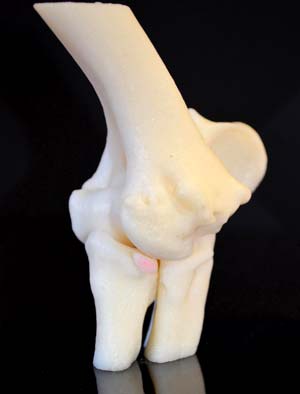3D Printing is the Vet’s New Best Friend

3D printed model of a dog’s elbow joint showing a bone chip (pink area). Courtesy of South Paws.
July 17, 2013
Like any good tool, additive manufacturing (AM) has a variety of uses. Beyond rapid prototyping and parts manufacturing, AM improves the lives of everyday people through its medical applications. Whether it’s a new ear or synthetic human tissue, 3D printing has become an important part of the health care field.
The technology doesn’t stop at helping humans, either. AM has helped out a duck with a malformed leg, an eagle without a beak, and probably many other feathered or furry patients I’ll never hear about. Along with building prosthetics, AM is used to treat animals in many of the same ways it helps human patients.
Cornell University employed 3D printing to prep for surgery on a German shepherd puppy named Bekka. A CT scan showed the puppy had an angular limb deformity that was causing her leg to grow crooked.
Doctors knew the condition would require surgery to correct, but wanted to prep for the operation by building a 3D replica of Bekka’s leg. The replica allowed Dr. Ursula Krotscheck to plan for the surgery, resulting in a two-hour operation that was a complete success.
“I knew what plate to use, how to contour the plate, where it should sit on the bone, and where the cuts should be made,” said Krotscheck. “All the decision-making was done 24 hours in advance. Having access to the models prior to surgery decreased the length of time Bekka was under anesthesia, decreased the time surgery took from start to finish, and ultimately decreased the risk of infection.”
Cornell isn’t alone in leveraging the power of AM to help animals. Australian veterinary clinic South Paws Specialty Surgery for Animals has found 3D printing to be of enormous help in not only planning operations, but in building bone replacement models, and creating surgical incision templates. As is the case with human patients, a 3D model is also useful for reassuring a worried family.
“Take for example, a dog that has a bone chip in the elbow joint. The initial CT scan or X-Ray will likely show the problem, but it is difficult to explain to the family how it has occurred and what treatment is required,” said Dr. Charles Kuntz, South Paws clinic founder. “With a 3D printed model of the joint showing where the damage has occurred, not only can the referring vet make a better judgment on whether specialist surgery is required, but can also show the pet owner how it will be done.”
Below you’ll find a video about South Paws.
Sources: South Paws Specialty Surgery for Animals, Cornell University
Subscribe to our FREE magazine, FREE email newsletters or both!
About the Author
John NewmanJohn Newman is a Digital Engineering contributor who focuses on 3D printing. Contact him via [email protected] and read his posts on Rapid Ready Technology.
Follow DE






